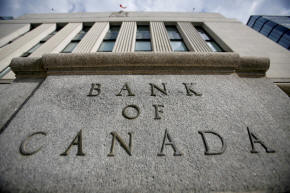Bank of Canada's second 50-bps hike seen locked in, but what comes next?
 Send a link to a friend
Send a link to a friend
 [June 01, 2022] By
Julie Gordon [June 01, 2022] By
Julie Gordon
OTTAWA (Reuters) - The Bank of Canada will
almost certainly go ahead with its second consecutive half-point
interest rate hike on Wednesday, as it scrambles to tame runaway
inflation before price increases become self-fulfilling. The big mystery
is what happens next.
All 30 economists surveyed by Reuters expect the central bank will hike
its policy rate to 1.5% from 1.0% in a decision at 10 a.m. ET (1400
GMT). That will follow April's 50-basis-point move, the first such
increase in more than two decades.
After teasing an even bigger lift, Governor Tiff Macklem made clear in
recent weeks that discussions ahead of Wednesday's decision would center
on another 50-basis-point increase.
Market watchers will be focused on the accompanying statement for any
hints what is yet to come, including whether an unprecedented third
consecutive half-percentage point increase is in the cards.

"I think the focus will be on the pace of future rate hikes, because
there is some question about what happens next," said Royce Mendes, head
of macro strategy at Desjardins Group.
Money markets have already fully priced in a third straight
50-basis-point increase in July, and investors are looking for clues
whether the cycle will peak with rates at or above 3%, a level not seen
since 2008.
Canada's inflation rate hit 6.8% in April, with food prices surging at
rates not seen since the early 1980s. If left unchecked, the Bank of
Canada risks a price spiral, making getting back to the 2% inflation
target even harder.
[to top of second column] |

A sign is pictured outside the Bank of Canada building in Ottawa,
Ontario, Canada, May 23, 2017. REUTERS/Chris Wattie/File Photo

Officials have made it clear they want to get the policy rate back in the
neutral range -- 2% to 3% -- but it won't be smooth sailing. The Bank was forced
to pause at 1.75% in the last cycle as higher rates wobbled the housing market
and consumer spending.
But, this time around, other areas of the economy may have to take a backseat to
inflation, at least until some of the heat comes off, said analysts.
"The game has completely changed this year as a result of such a high level of
inflation. The Bank really has to put the blinders on and hike rates," said Doug
Porter, chief economist at BMO Economics.
First-quarter economic growth disappointed on Tuesday, though it was almost
bang-on the central bank's forecast. A preliminary estimate for April showed
slowing home sales, caused by rising rates, were starting to weigh on growth.
But domestic demand was buoyant and household spending looked robust headed into
the second quarter.
(Reporting by Julie Gordon in Ottawa; additional reporting by Fergal Smith in
Toronto)
[© 2022 Thomson Reuters. All rights
reserved.]
This material may not be published,
broadcast, rewritten or redistributed.
Thompson Reuters is solely responsible for this content.
 |